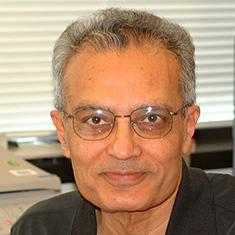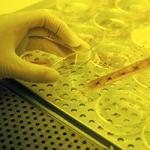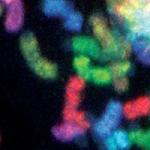
Research Topics
Regulation of Gene Transcription
Virtually every adaptation and developmental process originates at the level of gene regulation by transduction of extra- or intracellular signals. Transcription is the major target of regulation of gene expression. Our research interest covers modulation of transcription by DNA control elements and regulatory proteins, for example, repressors, activators, terminators, and antiterminators and their cognate signal molecules. We have demonstrated transcriptional regulation both at the level of initiation by activators and repressors and at the level of elongation by terminators and antiterminators in the gal operon which encodes enzymes of D-galactose metabolism in Escherichia coli. Presumably because of the amphibiotic nature of the biochemical pathway in carbon metabolism, the operon shows a multitude of controls at all levels of transcription and has been a paradigm system for studying control of transcription. The operon is transcribed from two promoters which are subject to both negative and positive control by at least four proteins, Gal repressor, Gal isorepressor, cyclic AMP receptor protein, and bacterial histone like protein, HU.
Major Findings:
- The two promoters of the gal operon are regulated by formation of a DNA loop. We have determined the structure, assembly and dynamics of the DNA loop, which constitute a higher order nucleoprotein complex (Gal repressosome). The characterization involves genetic and biochemical analysis, evaluation of DNA elastic energy, atomic force microscopy and in vitro single molecule analysis. In the Gal repressosome a DNA loop is formed by the interaction of two GalR dimers, bound to two spatially separated operators, OE and OI, flanking the gal promoters. Structure-based genetic analysis have indicated that GalR homodimers interact directly and form a V-shaped stacked tetramer in repressosome, which is further stabilized by HU binding to an architecturally critical position on the DNA. In this scheme of GalR tetramerization, the alignment of the operators in the DNA loop could be in either parallel (PL) or antiparallel (AL) mode. As each mode can have two alternative geometries differing in the mutual stacking of the OE - and OI -bound GalR dimers, it is feasible to have four different DNA trajectories in the repressosome. Our results show that OE and OI adopt a mutual AP orientation in an under-twisted DNA loop, consistent with the energetically optimal structural model. In this structure the center of the HU-binding site is located at the apex of the DNA loop. The approach reported here can be used to distinguish between otherwise indistinguishable DNA trajectories in complex nucleoprotein machines.
- We have demonstrated that a regulator inhibits or stimulates transcription initiation by disabling or stimulating RNA polymerase activity at a post-binding step by directly or indirectly altering the specific domain of RNA polymerase by a direct GalR-RNA polymerase contact(s) to an unfavorable or to a more favorable state, respectively. Base unpairing during isomerization of the closed to open complex at a promoter is an asynchronous process with a rate-limiting step as observed by 2, AP fluorescence kinetics.
- We have shown that a stretch of purines present in a specific transcribing region can override transcriptional pause signals by preventing RNA polymerase back-tracking created by the a pause signal.
- We have determined the axiom that determines the start point of transcription by RNA polymerase.
- Small molecules generally activate or inhibit gene transcription as externally added substrates or as internally accumulated end-products, respectively, Rarely has a connection been made that links an intracellular intermediary metabolite as a signal of gene expression. We have shown that a perturbation in the critical step of a metabolic pathway changes the dynamics of the pathways leading to accumulation of an intermediary metabolite. This accumulation causes cell stress and transduces signals that alter gene expression so as to cope with the stress by restoring balance in the metabolite pool. This underscores the importance of studying the global effects of alterations in the level of intermediary metabolites in causing stress and coping with it by transducing signals to genes to reach a stable state of equilibrium (homeostasis).
- From modeling studies, we have concluded that the structure of the regulatory network is insufficient for the determination of signal integration. It is the actual structure of the promoter and regulatory region, the mechanism of transcription regulation and the interplay between the transcription factors that shape the input function to be suitable for adaptation.
Regulatory Biology of Bacteriophage λ
The lysis-lysogeny decision of bacteriophage λ is a paradigm for developmental genetic networks. Two key features characterize the λ network. First, after infection of the host bacterium, a decision between lytic or lysogenic development is made that is dependent upon environmental signals and the number of infecting phages per cell. Second, the lysogenic prophage state is very stable. The CI and Cro regulators define the lysogenic and lytic states, respectively, as a bistable genetic switch. Whereas CI maintains a stable lysogenic state, recent studies indicate that Cro sets the lytic course not by directly blocking CI expression but indirectly by lowering levels of CII, which activates CI transcription. We are investigating how a relatively simple phage like λ employs a complex genetic network in decision-making processes, providing a challenge for theoretical modeling. Recently, we have made the following observations:
- The poles of bacteria exhibit several specialized functions related to the mobilization of DNA and certain proteins. To monitor the infection of Escherichia coli cells by light microscopy, we developed procedures for the tagging of mature bacteriophages with quantum dots. Surprisingly, most of the infecting phages were found attached to the bacterial poles. This was true for a number of temperate and virulent phages of E. coli that use widely different receptors and for phages infecting Yersinia pseudotuberculosis and Vibrio cholerae. Furthermore, labeling of λ DNA during infection revealed that it is injected and replicated at the polar region of infection. The evolutionary benefits that lead to this remarkable preference for polar infections may be related to λ developmental decision as well as to the function of poles in the ability of bacterial cells to communicate with their environment and in gene regulation.
- The lysogenic state of bacteriophage λ is exceptionally stable yet the prophage is readily induced in response to DNA damage. This delicate epigenetic switch is believed to be regulated by two proteins; the lysogenic maintenance promoting protein CI and the early lytic protein Cro. First, we have confirmed the previous observation that a DNA loop mediated by oligomerization of CI bound to two distinct operator regions OL and OR, increases repression of the early lytic promoters and is important for stable maintenance of lysogeny. Second, we have shown that the presence of the Cro gene might be unimportant for the lysogenic to lytic switch during induction of the lambda prophage.
- The spontaneous derepression of a λ prophage is less than mutational frequency. We have found by in vitro transcription system, that the extreme stability is because of DNA loop formation by interaction of CI-dimers to the right and left λ operators in the prophage state in a cross-wise cooperativity. Multilevel co-operativity in DNA loop discourages CI dissociation from the operators in stabilizing the prophage. It also shields prophage repression against lowering CI concentration and operator mutations.
- We have studied the stability of a DNA loop by tethered particle motion experiments in single DNA molecule experiments to study the dynamics of λ DNA looping. Modeling the thermodynamic data thus obtained established that the loop that involves 12-CI monomer is the stable one. The one that involves only 8 monomers has a positive free energy.
Bacterial Nucleoid
Bacterial necleoid organization is believed to have minimal influence on the global transcription program. Using an altered bacterial histone-like protein, HUα, we show that reorganization of the nucleoid configuration can dynamically modulate the cellular transcription pattern. The mutant protein transformed the loosely packed nucleoid into a densely condensed structure. The nucleoid compaction, coupled with increased global DNA supercoiling, generated radical changes in the morphology, physiology, and metabolism of wild-type Escherichia coli K-12. Many constitutive housekeeping genes involved in nutrient utilization were repressed, whereas many quiescent gene associated with virulence were activated in the mutant. We propose that, as in eukaryotes, the nucleoid architecture dictates the global transcription profile and, consequently, the behavior pattern in bacteria. We are investigating whether the E. coli nucleoid has a defined structure. In support of that we have made the following observations:
- Molecular mechanisms of bacterial chromosome packaging are still unclear. Among the factor facilitating DNA condensation may be a propensity of the DNA molecule for folding due to its intrinsic curvature. As suggested previously, the sequence correlations in genome reflect such a propensity. We analyzed positioning of A-tracts (the sequence motifs introducing the most pronounced DNA curvature) in the Escherichia coli genome. A-tracts are over-represented and distributed 'quasi-regularly' throughout the genome, including both the coding and intergenic sequences. There is a 10-12 bp periodicity in the A-tract positioning indicating that the A-tracts are phased with respect to the DNA helical repeat. The latter feature was revealed with the help of a novel approach based on the Fourier series expansion of the A-tract distance autocorrelation function. Since the A-tracts introduce local bends of the DNA duplex and may serve as binding sites for the nucleoid-associated proteins that have affinities for curved DNA. We have suggested that long clusters of the phased A-tracts constitute the 'structural code' for DNA compaction by providing the long-range intrinsic curvature and increasing stability of the DNA complexes with architectural proteins.
- We have determined the crystal structure of the Escherichia coli nucleoid-associated HU protein by x-ray diffraction and observed that the heterodimers form multimers with octameric units. It is of special importance that one of the structures forms spiral filaments with left-handed rotations. A negatively superhelical DNA can be modeled to wrap around this left-handed HU multimer, thus providing the structural explanation for the classical property of HU to restrain negative supercoils in DNA.
- The contribution of global nucleoid organization in determining cellular transcription programs is unclear. Using a mutant form of the abundant nucleoid-associated HU we showed that nucleoid remodeling by the mutant protein re-organizes the global transcription pattern. We have demonstrated that, unlike the dimeric wild-type HU, the mutant HU is an octamer and wraps DNA around its surface. The formation of wrapped nucleoprotein complexes by the mutant HU leads to a high degree of DNA condensation. The DNA wrapping in the mutant is right-handed, which restrains positive supercoils.
Bacteriophage Applications
Bacteriophage (phage) have been used in treatment of bacterial infections in humans since their discovery many decades ago, but the practice was discontinued because of lack of scrutiny required for Western medicine, and because of the discovery of potent antibiotics. Widespread occurrence today of drug resistant pathogens motivated us to attempt to revive phage-based diagnosis and treatment of bacterial infections using E. coli and Yersinia pestis as model systems.
In these studies, we used λ and T7-like phages that we mutated or engineered for use in therapy of experimental bacteremic animals, in the investigation of mutation rates in cancer cells and in the detection of E. coli and Yersinia pestis in clinical and environmental samples.
- Analysis of protein-protein interactions is critical in proteomics and drug discovery. Usage of a bacterial or yeast 2-hybrid system to detect protein-protein interaction is limited to an in vivo environment. Using the λ- display system, we have developed a phage-based 2-hybrid system for in vitro investigations.
Collaborators on this research include Victor Zhurkin, CCR, NCI, NIH, and Laura Finzi, Emory University, Atlanta, GA.
Biography
Selected Publications
- Wang X, N MPA, Jeon HJ, Lee Y, He J, Adhya S, Lim HM. Processing generates 3' ends of RNA masking transcription termination events in prokaryotes. Proc Natl Acad Sci U S A. 2019;116(10):4440-4445.
- Lee S, Lewis DEA, Adhya S. The Developmental Switch in Bacteriophage λ: A Critical Role of the Cro Protein. J Mol Biol. 2018;430(1):58-68.
- Keen EC, Bliskovsky VV, Malagon F, Baker JD, Prince JS, Klaus JS, Adhya SL. Novel "Superspreader" Bacteriophages Promote Horizontal Gene Transfer by Transformation. mBio. 2017;8(1).
- Qian Z, Adhya S. DNA repeat sequences: diversity and versatility of functions. Curr Genet. 2017;63(3):411-416.
- Lal A, Dhar A, Trostel A, Kouzine F, Seshasayee AS, Adhya S. Genome scale patterns of supercoiling in a bacterial chromosome. Nat Commun. 2016;7:11055.
Related Scientific Focus Areas



Microbiology and Infectious Diseases
View additional Principal Investigators in Microbiology and Infectious Diseases

Molecular Biology and Biochemistry
View additional Principal Investigators in Molecular Biology and Biochemistry

This page was last updated on Wednesday, May 14, 2025